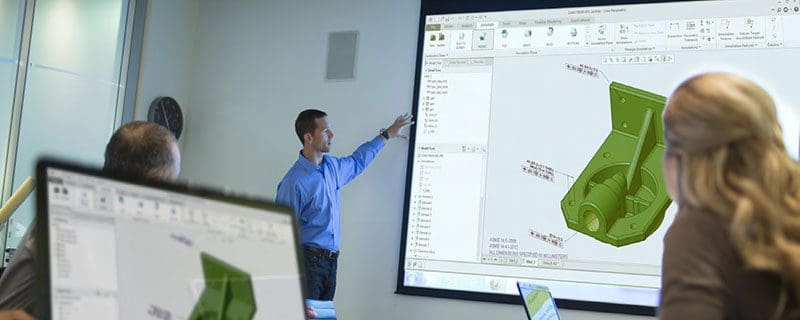June 6, 2022
Model Based Enterprise – Three Commitments to Success!
READ TIME: 3.9 MINS
What is Model Based Enterprise (MBE)?
When your company decides to use a Model Based Enterprise approach it makes 3D CAD models the source authority for your entire company and all its engineering activities. This means that up-to-date information is accessible right away so that nobody wastes time searching for data.
In such a system, powered by the Creo CAD software, the company CEO looks at the CAD model through a viewer, the manufacturing engineer runs tool paths off the model, and the design engineer uses the model to run simulations. Associative CAD and PLM (product lifecycle management) systems ensure that design intent remains uniform between both, simplifying the creation of rich and reliable Bills of Materials (BOMs). This is just the beginning when it comes to the benefits of digital transformation!
At TriStar PLM Solutions, we are proud to have helped many manufacturers get started with their product ideas and business goals. Getting started can be difficult, so we want to make the process as easy as possible by using proven methodologies. Our most successful Model Based Enterprise customers make three main commitments.
Three Commitments to a Successful Model Based Enterprise
Commit to Cleaning Data.
Commit to Model Based Definition (MBD).
Commit to Starting Small and Close to Home.

1. Commitment to Clean Data
The first commitment is to clean data which is usually the most complex, time-consuming, and important. It can take years to properly set up and complete, so we advise our customers not to rush through the process or cut corners. We break the process of getting your “digital house” in order into (at least) three major sub-components. As you gradually complete your digital transformation plan, you’ll slowly get rid of your business’s old data, soiled information, and homegrown processes that are not part of a proven methodology.
At TriStar PLM Solutions, we define clean data as a 3D CAD model that is properly documented, not a space claim or the shape of an object with other information living somewhere else in the company or at a supplier. In addition, clean data is easily read digitally, by humans, and throughout your entire enterprise.
The good news is that you can begin with three activities you probably intended to do anyway:
Build Design Engineers’ Modeling Skills: Reduce avoidable errors and ensure your design teams get the most out of their existing Creo CAD Software.
Avoid the “Primrose Path:” Processes that are derived from ‘homegrown workarounds’ or as part of a process that hasn’t been examined in awhile, should be removed.
Get Complete, Traceable Data: Take your product from a Creo CAD model to production with precisely the same data.

2. Commit to Model Based Definition (MBD)
The second commitment to your Model Based Enterprise, is to Model Based Definition (MBD). An approach to product engineering that makes the CAD model the complete source authority instead of the 2D drawing, carries the danger of being out of sync with the model. This will help your team avoid what one design engineer called “Days of Dread.” This term was used to describe the work weeks where she would sit in her office waiting for the inevitable calls from the manufacturing floor.
Model based definition allows for better communication between your design and manufacturing teams, helping to ensure that products are manufactured to the highest quality standards. It also reduces the need for costly and time-consuming physical prototypes, which helps to speed up the product development process.
A model based enterprise takes time to build. Start by choosing a small, well-defined project that has the enthusiastic support of those in the data’s chain of custody. Your stakeholders will view glitches and surprises as an inevitable part of doing interesting, important work. Below are three types of projects you can begin to start realizing the benefits of digital transformation:
3. Commit to Starting Small and Close to Home
A model-based enterprise takes time to build. Start by choosing a small, well-defined project that has the enthusiastic support of those in the data’s chain of custody. Your stakeholders will view glitches and surprises as an inevitable part of doing interesting, important work.
Understanding what is model-based enterprise helps you realize the benefits:
Prototype Reduction: Build your Creo CAD model, look at the kinematics, and eliminate a series of iterative prototype steps.
Reduce-Instruction Drawing: Move information that would normally be on the 2D drawing such as GD&T, to the 3D model.
CNC Machining: Eliminate scrap and expensive tooling by using CNC machining software and setting the machine and tool paths directly on the model; instead of the factory floor.

Final Thoughts on Model Based Enterprise
You can’t buy your way to the successful adoption of a Model-Based Enterprise approach. No amount of new software, nor a transformative capability, will allow you to skip steps on this digital transformation plan. Don’t let the length of this journey keep you from experiencing the benefits of digital transformation! Completing bite-sized parts of this project will give you evidence to prove broader value to your business and will build your momentum. You’ll have contributed to reducing error, design time, cutting costs, and reducing time to market.
We’d argue that starting the Model-Based Enterprise journey is necessary for you to get the most out of your Creo CAD software and that it will likely bring you a step closer to becoming a more innovative company. Freeing up highly skilled engineers, giving management a clearer view of what’s happening, and making data available across your enterprise makes innovation more likely.
Don’t wait to start your MBE journey, contact us today!
TriStar Digital Thread Solutions welcomes questions. Feel free to CONTACT US if you can’t find what you’re looking for, or call us at 800-800-1714









Leave A Comment